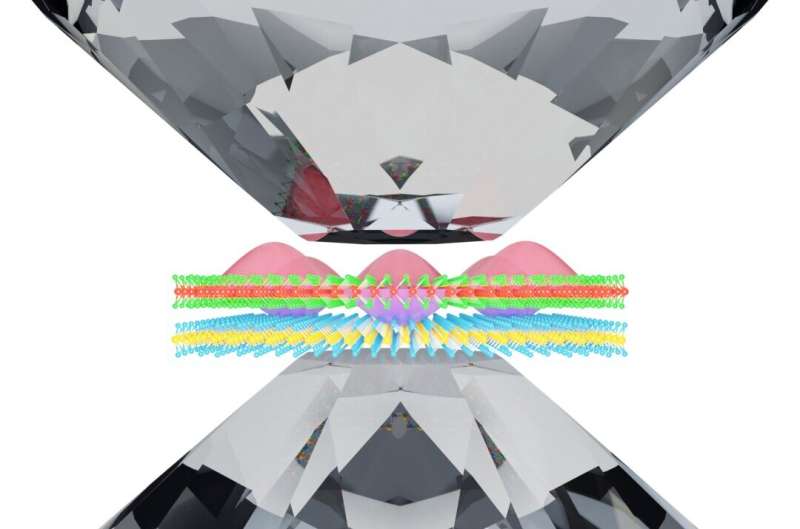
Physicists have been riveted by
systems composed of materials only one or a few layers of atoms thick. When a
few sheets of these two-dimensional materials are stacked together, a geometric
pattern called a moiré pattern can be formed. In these so-called moiré systems,
new, exotic phenomena can occur, including superconductivity and unconventional
magnetism.
As a result, a better understanding of what happens at the interface between each sheet to cause these phenomena could lead to heady applications in novel electronics and much more.
Now an international team of scientists led by physicists at MIT reports a powerful new tool for quantifying—and controlling—a key parameter in moiré systems. It involves applying extreme pressure to a moiré system while shining light through it, then analyzing the effects with Raman spectroscopy, a common laboratory technique.
Equally important to the work is a theoretical model that provides a framework for understanding the experimental data.
The work is reported in Nature Nanotechnology.
"The technique we developed for probing these moiré systems is methodologically similar to the methods of X-ray crystallography on proteins that allow biologists to know where the atoms are in a protein and how the protein is going to work," says Riccardo Comin, the Class of 1947 Career Development Assistant Professor of Physics at MIT.
The parameter the team can now measure, known as the moiré potential, "is going to tell us what physics can be realized in a particular stack of two-dimensional materials. It is one of the most important pieces of information that we need for predicting if a given material is going to exhibit any exotic physics, or not," continues Comin, who is also affiliated with MIT's Materials Research Laboratory.
Just as importantly, the technique also allows the team to "tune," or control, the moiré potential to potentially achieve different exotic phenomena.
Matthew Yankowitz, an assistant professor of physics at the University of Washington who was not involved in the work, says, "Pressure has recently emerged as a promising technique for tuning the properties of these [moiré] materials because it directly modifies the strength of the moiré potential. By studying the optical properties of a semiconducting moiré bilayer under pressure, the team has unlocked a new means of probing and manipulating the effects of a moiré superlattice. This work lays the foundation for further advances in our understanding and control of the strongly correlated states of matter arising in semiconducting moiré systems."
The work reported in Nature Nanotechnology is the result of a collaboration between researchers at MIT, Universidad Nacional Autónoma de México (UNAM), and three federal universities in Brazil: Universidade Federal de Minas Gerais (UFMG), Universidade Federal de Ouro Preto (UFOP), and Universidade Federal Fluminense (UFF).
Extreme pressure, miniscule samples
The experimental setup the team developed for applying extreme pressure to a moiré material, in this case composed of two ultrathin sheets of a transition metal dichalcogenide, involves compressing the material between two diamond tips. The dimensions of the setup and sample are incredibly small. For example, the diameter of the chamber where this takes place is similar to the width of a human hair. "And we need to precisely place our two-dimensional sample inside of that, so it's a bit tricky," says Martins, leader of the work to develop the setup.
Those dimensions are necessary to create the extreme pressure exerted on the sample, which is akin to the pressure the Eiffel Tower would exert sitting on top of a one-inch-square piece of paper. Another analogy: the pressure is some 50 thousand times the pressure of the air around us.
Experiments and theory
The team then shone light through the sample, and collected the light that was emitted. "The light leaves some energy inside of the material, and this energy can be associated with different things," Martins said. In this case, the team focused on energy in the form of vibrations. "By measuring the difference between the energies of photons [light particles] coming in and out of the material, we can probe the energy of vibrations created in the material," he continues.
The intensity of the light coming out of the material associated with those vibrations, in turn, indicates how strongly the electrons in one atomically thin sheet are communicating with the electrons in the other. The stronger those interactions, the better the chance that exotic phenomena will occur. "The moiré potential is basically the strength of that coupling between the 2D layers," says Comin.
Says Martins, "By comparing the experimental enhancement of the intensity of the out-going light associated with these vibrations, versus the calculations of our theoretical model, we were able to obtain the strength of the moiré potential and its evolution with pressure."
The theoretical model, developed by Ruiz-Tijerina, is in itself very sophisticated. Says Comin, "It's a complex model because it involves atoms, it involves electrons, and it's a so-called large super cell model. That means you don't model just a single quantity, like a single atom with its electrons, but a big collection of them. It really looks at the dynamics of the atoms while they're still interacting with the electrons around them."
Ruiz-Tijerina concludes, "When the experiment shows what you predicted, or when your model can actually reproduce what the experiments measure, that's a feeling like no other."

 Previous page
Previous page Back to top
Back to top







